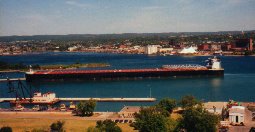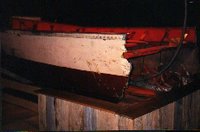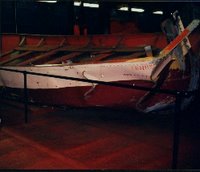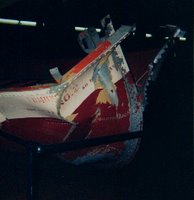The legend lives on from the Chippewa on down
Of the big lake they call 'Gitche Gumee'.
Superior, they said, never gives up her dead
When the gales of November come early!
In the summer of 1997, my friends Kim and Jenni and I set off for a week long tour of Michigan's Upper Peninsula. We spent the first couple days with friends in Copper Harbor, in the Keweenaw Peninsula -- Michigan's "upper upper peninsula" -- where we toured waterfalls and lighthouses along Lake Superior, and visited historic Fort Wilkins before heading east to a campground outside Sault Ste. Marie.
 Our first day near the Soo, we drove west to the Point Iroquois Light, which is no longer in service and has been restored as a museum. We toured the living quarters of the light station, then climbed the tower overlooking Lake Superior before continuing northwest to Whitefish Point and the Great Lakes Shipwreck Museum.
Our first day near the Soo, we drove west to the Point Iroquois Light, which is no longer in service and has been restored as a museum. We toured the living quarters of the light station, then climbed the tower overlooking Lake Superior before continuing northwest to Whitefish Point and the Great Lakes Shipwreck Museum.Whitefish Point, known as the Graveyard of Ships, has seen the loss of more vessels than any other part of the lake. The Whitefish Point lighthouse marks the end of an 80 mile stretch of shoreline known as 'Lake Superior's Shipwreck Coast' -- great location for marine archeologists and divers, but not so great for ships. Hundreds lie at the bottom of the bay and its approaches, including the famed Edmund Fitzgerald.
If you turned on the television or radio, or picked up a newspaper this week, you probably know that today, November 10, marks the 30th anniversary since the freighter sunk during a fierce storm on Lake Superior . All 29 crew members perished in the wreck. The Edmund Fitzgerald is certainly not the first vessel to be swallowed up by the Great Lakes -- more than 6,000 ships and 30,000 lives have been lost over the years -- but it is the most well-knownthanks to the haunting lyrics of Gordon Lightfoot's The Wreck of the Edmund Fitzgerald. The song and the images it invokes stay with you, and thus, the Edmund Fitzgerald stands as a reminder of all those lost at sea. Each November at the annual memorial service, the bell is rung 29 times for each member of the Fitzgerald and once more in remembrance of the thousands of other mariners lost on the Great Lakes.
At Whitefish Point, we wandered through the shipwreck museum, an experience like no other. We read accounts of some of the worst shipwrecks of the Great Lakes, learned about sailing and maritime history, and were educated in advancements made in equipment and the various vessels sailed on the lakes. At the end of our tour we arrived at the 200 lb. bronze bell of the Edmund Fitzgerald. The only item ever brought up from the freighter, it serves as a memorial to those lost. The bell was recovered in 1995 at the request of family members, and a replica of it, engraved with the names of the 29 crew members, was left in its place.
Most poignant at this stop is the short film shown on the wreck and recovery of the bell. There wasn't a dry eye in that theater when we left. No man or woman hearing the haunting melody of Lightfoot's ballad threaded through accounts and speculations as to what happened that night, the first person stories of loved ones left behind, and images from the recovery of the original bell and annual memorial service, could exit without at least one tear brought to their eyes. It reminds you how precipitous life is, how capricious a strong wind and roiling seas can be -- how fast conditions can change and lives altered...or lost. It was a lesson well-remembered only a few months later, when Jenni was suddenly taken from us on a cold December morning.
 The following afternoon found us in Sault Ste. Marie where we watched freighters passing through the Soo Locks and took the boat tour up the St. Mary's River through the locks to Lake Superior and as far as the International Bridge. We also visited the Museum Ship Valley Camp, a retired steamer that has been turned into a maritime museum. This is where the two lifeboats and a life preserver from the Fitzgerald are housed -- the only major articles to surface following the tragedy.
The following afternoon found us in Sault Ste. Marie where we watched freighters passing through the Soo Locks and took the boat tour up the St. Mary's River through the locks to Lake Superior and as far as the International Bridge. We also visited the Museum Ship Valley Camp, a retired steamer that has been turned into a maritime museum. This is where the two lifeboats and a life preserver from the Fitzgerald are housed -- the only major articles to surface following the tragedy.Looking down the Valley Camp
Remains of the No. 1 lifeboat and one view of the No. 2 boat.

Sign posted by the No. 2 lifeboat.
Two more views of the No. 2 lifeboat.










1 comment:
Great story and pics. Must've been awesome to SEE all that history.
Post a Comment